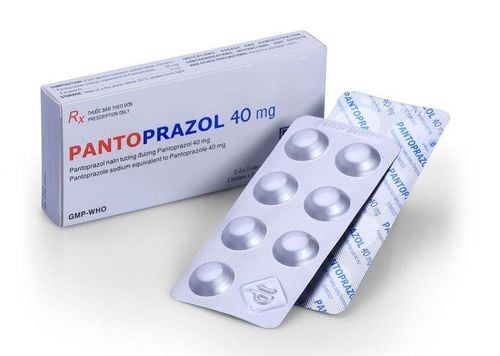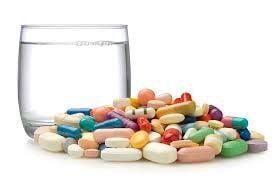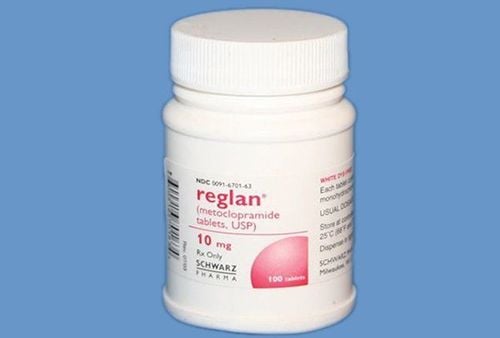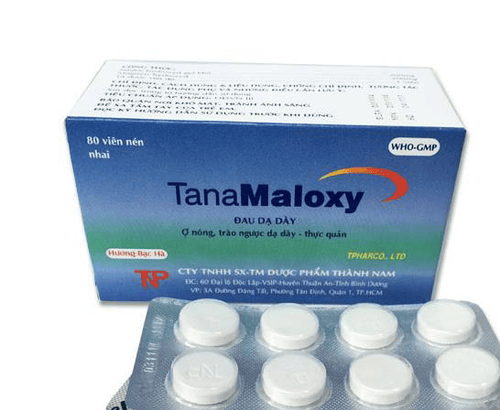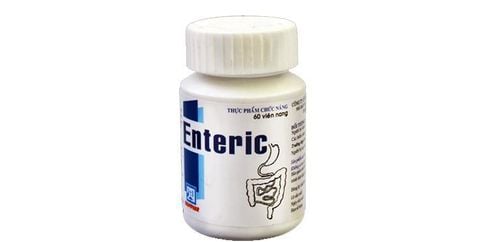This is an automatically translated article.
If you or a loved one often have gastrointestinal problems, you are no stranger to Alumina. But on the market today there is a lot of information about drug products Alumina. This article will help you answer the questions: What is Alumina? What diseases does Alumina treat and what should be noted when using it?
1. What is Alumina and what disease does it treat?
Alumina is a drug often recommended to reduce muscle spasms in patients with peptic ulcer disease, or excess acid in the stomach. In addition, the drug Alumina has a number of other effects that will be prescribed by specialized doctors and pharmacists. In case the patient wants to learn more about the effect of Alumina, they should ask directly qualified people for answers.
The specific effects of Alumina:
Alumina helps relieve symptoms caused by increased stomach acid (heartburn, heartburn, bloating and indigestion due to increased acid). Alumina is used in cases of increased stomach acid due to gastric and duodenal ulcers. Alumina is used to prevent and treat ulcers and gastrointestinal bleeding caused by stress. Alumina is used in the treatment of gastroesophageal reflux disease. Alumina is used for patients with hyperphosphatemia: together with a low phosphate diet. However, in patients with renal failure, taking aluminum-containing antacids as a phosphate binder (to remove phosphate) can lead to aluminum toxicity.
Alumina has the main ingredients Aluminum hydroxide, Calcium carbonate, magnesium carbonate, Atropine sulfate belongs to the group of antacids, supports the treatment of stomach and duodenal ulcers, reduces symptoms caused by increased stomach acid. .
The drug is quickly and completely absorbed by the body in the gastrointestinal tract.
Elimination: in 2 ways
Through feces: Part Al3+, Mg2+, Ca2+ insoluble Through the kidneys: Part Al3+, Mg2+, Ca2+ is absorbed Part of atropine sulfate is excreted by the kidneys
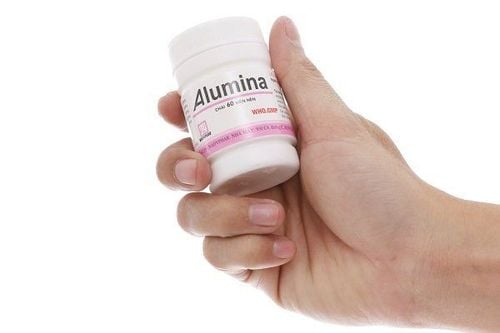
Thuốc Alumina được dùng trong một số bệnh lý dạ dày tá tràng
2. Mechanism of action of the drug Alumina
2.1. Pharmacokinetics The aluminum hydroxide component of alumina is slowly soluble in the stomach and reacts with gastric hydrochloric acid to form aluminum chloride and water. In which, in people with normal renal function, about 17-30% of aluminum chloride formed is absorbed and eliminated rapidly by the kidneys.
When passing through the small intestine, aluminum chloride is rapidly converted to alkaline aluminum salts, insoluble, and poorly absorbed. In addition, the aluminum component in antacids (except aluminum phosphate) combines with ingested phosphate to form insoluble aluminum phosphate in the intestines and is excreted in the stool of the patient. If the diet is low in phosphate, aluminum-containing antacids reduce phosphate absorption and cause hypophosphatemia and urinary hypophosphatemia.
The drug combines the active ingredients Magnesium carbonate, Aluminum hydroxide, Calcium carbonate, so it has the properties of creating a protective film on the lining of the stomach and duodenum, enhancing absorption and neutralizing gastric acid in the stomach. In addition, the drug also has an ingredient called Atropin Sulfate, so it has a more effective analgesic and antispasmodic effect.
The active ingredients Calcium carbonate, Aluminum hydroxide and Magnesium hydroxide dissolve in gastric acid, neutralize stomach acid by releasing anions, or act as a buffer for the production of stomach acid, but do not affect the formation of gastric juice. The drug makes the symptoms due to increased stomach acid significantly reduced, the acid concentration in the esophagus also decreases and inhibits the enzyme pepsin to digest protein; These mechanisms are very important in patients with peptic ulcer disease. At the same time, the laxative effect of magnesium hydroxide also reduces the constipating effect of aluminum hydroxide. In addition, Atropin and other drugs in the same class competitively inhibit acetylcholine and other muscarinic system stimulants, preventing acetylcholine from binding to muscarinic receptors in both the central and peripheral nerves. This causes central nervous system stimulation and parasympathetic destruction.
2.2. Contraindications of the drug alumina Do not use Alumina for all patients with hypersensitivity to any component of the drug and children under 6 years of age.
Patient has kidney failure. If necessary, consider aluminum hydroxide content. Patients with hypophosphataemia (related to aluminum hydroxide). Blood chemistry should be checked periodically if long-term treatment is required. The patient has hypermagnesaemia (related to magnesium carbonate). Blood chemistry should be checked periodically if long-term treatment is required. Patients with prostatic hypertrophy (causing urinary retention), pyloric stenosis, myasthenia gravis, paralytic ileus, glaucoma (associated with atropine sulfate). Use with caution in pregnant and lactating women.

Người bệnh suy thận nằm trong nhóm chống chỉ định dùng thuốc Alumina
2.3. Other Drug Interactions Alumina Antacids interact with a number of other drugs that are absorbed orally. Use caution when combining drugs with the following drugs due to drug interactions causing reduced absorption from the gastrointestinal tract:
Anti-tuberculosis drugs (ethambutol, isoniazid), cyclines, fluoroquinolones, lincosamides, - H2 antihistamines, atenolol, metoprolol, propranolol , chloroquine, diflunisal, digoxine, diphosphonate, fluoride sodium, glucocorticoids (specifically prednisolone and dexamethasone), indomethacin, ketoconazole, lansoprazole Phenothiazine neuroleptics, penicillamine, phosphorus, iron salts, sparfloxacin Kayexalate: Decreased binding of resin into potassium, in patients with renal failure at risk of metabolic alkalosis. Therefore, antacids should be used more than 2 hours apart and more than 4 hours for fluoroquinolones.) Note when combining: Salicylate derivatives present in Alumina cause increased renal excretion of salicylates due to alkalinization of urine.
3. Dosage and how to use Alumina
3.1. Instructions for use Alumina Tablets but will be taken by chewing thoroughly before swallowing.
Read the instructions for use carefully to use exactly as recommended by the manufacturer.
Strictly follow the instructions of qualified people, do not arbitrarily increase or decrease the dose according to your own preferences.
Use persistently even if there are improvements in the condition of the disease. If the severity of the disease, you should ask the doctor, pharmacist about the dosage increase or decrease or in combination with any drug, absolutely the patient should not increase or decrease at his own discretion.
In case you miss a dose, you should take it at the nearest time, but if it is close to the next dose, you should take the next dose and absolutely do not take a double dose.
If you have any questions or concerns during drug use, you should ask qualified people for answers. If the patient's condition worsens during drug treatment, the patient should notify the doctor and pharmacist for a change in dosage or an appropriate alternative.
3.2. Dosage for adults Used in the treatment of peptic ulcers
Use 1-2 tablets, should be taken after meals or at bedtime.
Maximum dosage should not exceed 6 tablets within 1 day.
In severe cases or symptoms have improved, you should consult your doctor, pharmacist before intending to increase or decrease the dose.

Người bệnh nên dùng thuốc Alumina đúng liều lượng
3.3. Dosage for children Alumina medicine used in the treatment of children with peptic ulcer disease should follow the doctor's instructions and specifically:
For children over 6 years old: Use alumina by 1/2 the adult dose. For children under 6 years of age: Before using alumina, parents should carefully consult a doctor, a specialist pharmacist to get the correct dose and usage, to avoid health hazards for children. little. Note: The above dosage is only theoretical and for reference only. The exact dose of alumina depends on the patient's condition and the progression of the disease. And consulting, consulting with doctors or pharmacists is very necessary. 3.4. What to do in case of an overdose of alumina Reduces blood phosphate levels (causes encephalopathy, dementia, osteomalacia, microcytic anemia). Increased blood magnesium levels in patients with severe renal impairment (causing mental impairment, hypotension, even coma). Treatment: Stop using the drug immediately. With mild adverse reactions, discontinuation of the drug is usually sufficient. In case of hypersensitivity or allergic reaction, it is necessary to conduct supportive treatment (need ventilation and use epinephrine, oxygen if breathing difficulty, use antihistamines and corticosteroids...).
4. Precautions when using Alumina
Here are a few notes when using alumina for patients such as:
For the elderly and children, when using alumina to treat diseases, you should pay attention to the dosage and recommendations reported, because at this age there is a greater sensitivity to the drug than other people. Before using Alumina, it is necessary to periodically check the patient's phosphate level if treatment is required for a long time. Alumina is safe to use for women during pregnancy, but should consult a doctor before using because each person's body and pregnancy will be different. Care should be taken to store alumina when not in use. Alumina should be stored in an airtight container at room temperature and out of the reach of children and pets. Above is the important information about the drug Alumina. You need to be very careful to ensure that the medication is effective as expected.
Please dial HOTLINE for more information or register for an appointment HERE. Download MyVinmec app to make appointments faster and to manage your bookings easily.




